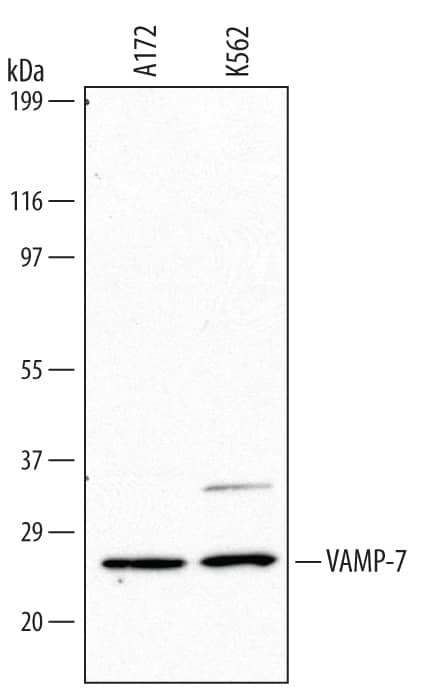Human VAMP-7 Antibody
R&D Systems, part of Bio-Techne | Catalog # MAB6117

Key Product Details
Validated by
Species Reactivity
Validated:
Cited:
Applications
Validated:
Cited:
Label
Antibody Source
Product Specifications
Immunogen
Ala2-Met140
Accession # P51809
Specificity
Clonality
Host
Isotype
Scientific Data Images for Human VAMP-7 Antibody
Detection of Human VAMP‑7 by Western Blot.
Western blot shows lysates of A172 human glioblastoma cell line and K562 human chronic myelogenous leukemia cell line. PVDF Membrane was probed with 1 µg/mL of Mouse Anti-Human VAMP-7 Monoclonal Antibody (Catalog # MAB6117) followed by HRP-conjugated Anti-Mouse IgG Secondary Antibody (Catalog # HAF007). A specific band was detected for VAMP-7 at approximately 25 kDa (as indicated). This experiment was conducted under reducing conditions and using Immunoblot Buffer Group 1.Detection of Human VAMP-7 by Western Blot
Amphisome/lysosome fusion is not required for autophagy-mediated exosomal secretion of ANXA2. (a) Cells with VAMP7 knockdown and control knockdown were transfected with a GFP-LC3 plasmid and treated with or without 500 U/ml IFN-gamma for 24 h. Cells were then fixed, permeabilized, and stained for ANXA2 (red) and LAMP1 (blue). The colocalization of ANXA2, GFP-LC3 and LAMP1 was observed by confocal microscopy. Scale bar: 10 μm. The arrow and dotted inset mark an autolysosome. (b) Line tracing analysis of fluorescence signal from image in (a) of VAMP7 knockdown and control knockdown cells after IFN-gamma stimulation is shown. (c) VAMP7 knockdown efficiency was detected by western blotting. Control and VAMP7-silenced cells were treated with or without 500 U/ml IFN-gamma for 48 h. The exosome pellets were collected. ANXA2, alpha-tubulin, Tsg101 and calnexin from exosome pellets and total cell lysates were detected by western blotting. kD, molecular weight as kDa. (d) A549 cells were incubated with 500 U/ml IFN-gamma in the presence or absence of 5 nM bafilomycin A1 for 48 h. ANXA2 and alpha-tubulin from cultured supernatant and total cell lysate were analyzed by western blotting. kD, molecular weight as kDa. Image collected and cropped by CiteAb from the following publication (https://pubmed.ncbi.nlm.nih.gov/28720835), licensed under a CC-BY license. Not internally tested by R&D Systems.Applications for Human VAMP-7 Antibody
Immunohistochemistry
Sample: Immersion-fixed paraffin-embedded sections of human breast and human breast cancer tissue
Western Blot
Sample: A172 human glioblastoma cell line and K562 human chronic myelogenous leukemia cell line
Reviewed Applications
Read 2 reviews rated 5 using MAB6117 in the following applications:
Formulation, Preparation, and Storage
Purification
Reconstitution
Formulation
Shipping
Stability & Storage
- 12 months from date of receipt, -20 to -70 °C as supplied.
- 1 month, 2 to 8 °C under sterile conditions after reconstitution.
- 6 months, -20 to -70 °C under sterile conditions after reconstitution.
Background: VAMP-7
Vesicle-associated membrane protein 7 (VAMP-7) is a 25 kDa, widely expressed, type IV transmembrane protein and member of the synaptobrevin family. Mature human VAMP-7 consists of a 187 aa cytoplasmic domain, a 21 aa transmembrane region, and an 11 aa vesicular region. The cytoplasmic domain contains a longin domain (aa 7‑110) and a v-SNARE coiled-coil homology domain (aa 125‑185). Two splicing variants produce three isoforms for human VAMP-7. Isoform 2 has a 116 aa substitution for aa 145‑220 found in isoform 1, and isoform 3 is missing the residues corresponding to aa 28‑68 in isoform 1. Human VAMP-7 shares 99%, 97%, and 95% aa sequence identity with bovine, mouse, and rat VAMP-7, respectively.
Long Name
Alternate Names
Gene Symbol
UniProt
Additional VAMP-7 Products
Product Documents for Human VAMP-7 Antibody
Product Specific Notices for Human VAMP-7 Antibody
For research use only

